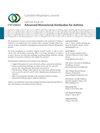神经元特异性烯醇化酶在结节病诊断和疾病监测中的作用
IF 2.1
4区 医学
Q3 RESPIRATORY SYSTEM
引用次数: 5
摘要
结节病是一种病因不明的系统性肉芽肿性疾病。结节病的诊断是基于临床病理结果,并伴有多器官肉芽肿的形成,包括肺。虽然血管紧张素转换酶(ACE)和可溶性白细胞介素2受体(sIL-2R)传统上用于结节病的诊断,但具体的诊断标志物仍有待确定。在目前的研究中,我们发现结节病患者血清神经元特异性烯醇化酶(NSE)水平升高。血清NSE水平与血清ACE、sIL-2R水平呈正相关。NSE单独检测的敏感性一般,但与sIL-2R和ACE联合检测的敏感性最高。将SCLC患者血清NSE和前胃泌素释放肽(ProGRP)水平与结节病和非结节性良性疾病患者进行比较,血清NSE可用于SCLC与结节病和非结节病的区分,临界值为17.0 ng/ml,敏感性为73.5%,特异性为90.2%,与ProGRP相当。血清NSE水平与器官受损伤相关,并且在接受口服皮质类固醇(OCS)治疗的结节病患者中,NSE水平高于从未接受过OCS治疗的结节病患者;血清NSE水平升高与OCS使用呈正相关。自发性缓解后,非缓解期患者血清NSE浓度升高降低,而结节病患者随访期间血清NSE水平随血清ACE或sIL-2R水平波动。这些结果提示,NSE可作为结节病患者临床预后的诊断和监测指标。本文章由计算机程序翻译,如有差异,请以英文原文为准。
Role of Neuron-Specific Enolase in the Diagnosis and Disease Monitoring of Sarcoidosis
Sarcoidosis is a systemic granulomatous disease of unknown etiology. The diagnosis of sarcoidosis is based on clinicopathologic findings accompanied by the formation of granulomas in multiple organs, including the lung. Although angiotensin-converting enzyme (ACE) and soluble interleukin 2 receptor (sIL-2R) are traditionally used for the diagnosis of sarcoidosis, specific diagnostic markers remain to be determined. In the current study, we found that serum neuron-specific enolase (NSE) levels were elevated in patients with sarcoidosis. Serum NSE levels were positively correlated with serum ACE and sIL-2R levels. The sensitivity of NSE alone was modest, but its combination with sIL-2R and ACE had the highest sensitivity compared to those of each single marker. When comparing serum NSE and pro-gastrin-releasing peptide (ProGRP) levels in SCLC patients with those in patients with sarcoidosis and nonsarcoidotic benign diseases, serum NSE could be used to distinguish SCLC from sarcoidosis and nonsarcoidosis by setting at a cutoff value of 17.0 ng/ml with a sensitivity of 73.5% and a specificity of 90.2%, which were comparable to those of ProGRP. Serum NSE levels were associated with organ involvement and were higher in sarcoidosis patients who had been treated with oral corticosteroid (OCS) than in those who had never received OCS therapies; there was a positive association between elevated serum NSE levels and OCS use. Increased concentrations of serum NSE in patients at the nonremission phase decreased after spontaneous remission, whereas serum NSE levels fluctuated in accordance with serum ACE or sIL-2R levels during the follow-up period in patients with sarcoidosis. These findings suggest that NSE could be a marker for the diagnosis and monitoring of the clinical outcome of patients with sarcoidosis.
求助全文
通过发布文献求助,成功后即可免费获取论文全文。
去求助
来源期刊

Canadian respiratory journal
医学-呼吸系统
CiteScore
4.20
自引率
0.00%
发文量
61
审稿时长
6-12 weeks
期刊介绍:
Canadian Respiratory Journal is a peer-reviewed, Open Access journal that aims to provide a multidisciplinary forum for research in all areas of respiratory medicine. The journal publishes original research articles, review articles, and clinical studies related to asthma, allergy, COPD, non-invasive ventilation, therapeutic intervention, lung cancer, airway and lung infections, as well as any other respiratory diseases.
 求助内容:
求助内容: 应助结果提醒方式:
应助结果提醒方式:


